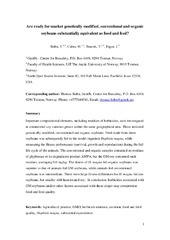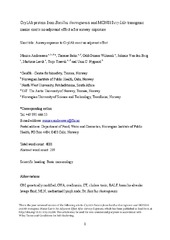Blar i forfatter "Traavik, Terje"
-
Are ready for Market Genetically Modified, Conventional and Organic Soybeans Substantially Equivalent as Food and Feed?
Bøhn, Thomas; Cuhra, Marek; Traavik, Terje; Fagan, John (Chapter; Bokkapittel, 2015)Important compositional elements, including residues of herbicides, were investigated in commercial soy varieties grown within the same geographical area. These included genetically modified, conventional and organic soybeans. Feed made from these soybeans was subsequently fed to the model organism Daphnia magna, while measuring the fitness performance (survival, growth and reproduction) during the ... -
Clone- and age-dependent toxicity of a glyphosate commercial formulation and its active ingredient in Daphnia magna.
Cuhra, Marek; Traavik, Terje; Bøhn, Thomas (Journal article; Tidsskriftartikkel; Peer reviewed, 2013)Low levels of glyphosate based herbicide induced significant negative effects on the aquatic invertebrate Daphnia magna. Glyphosate herbicides such as brands of Roundup, are known to be toxic to daphnids. However, published findings on acute toxicity show significant discrepancies and variation across several orders of magnitude. To test the acute effects of both glyphosate and a commercial ... -
Compositional differences in soybeans on the market: glyphosate accumulates in Roundup Ready GM soybeans
Bøhn, Thomas; Cuhra, Marek; Traavik, Terje; Sanden, Monica; Primicerio, Raul (Journal article; Tidsskriftartikkel; Peer reviewed, 2014)This article describes the nutrient and elemental composition, including residues of herbicides and pesticides, of 31 soybean batches from Iowa, USA. The soy samples were grouped into three different categories: (i) genetically modified, glyphosate-tolerant soy (GM-soy); (ii) unmodified soy cultivated using a conventional ‘‘chemical’’ cultivation regime; and (iii) unmodified soy cultivated using an ... -
Cry1Ab Protein from Bacillus thuringiensis and MON810 cry1Ab-transgenic Maize Exerts No Adjuvant Effect After Airway Exposure
Andreassen, Monica; Bøhn, Thomas; Wikmark, Odd Gunnar; van den Berg, Johnnie; Løvik, Martinus; Traavik, Terje; Nygaard, Unni Cecilie (Journal article; Tidsskriftartikkel; Peer reviewed, 2015-02-24)The genetically modified (GM) maize event MON810 has been inserted with a processed version of the transgene, cry1Ab, derived from the soil bacterium Bacillus thuringiensis (Bt) to express proteins with insecticidal properties. Such proteins may introduce new allergens and also act as adjuvants that promote allergic responses. While focus has been on safe consumption and hence the oral exposure to ... -
Genetically Engineered Virus Vaccine Vectors: Environmental Risk Management Challenges
Myhr, Anne Ingeborg; Traavik, Terje (Journal article; Tidsskriftartikkel; Peer reviewed, 2011) -
The German ban on GM maize MON810: scientifically justified or unjustified?
Bøhn, Thomas; Primicerio, Raul; Traavik, Terje (Journal article; Tidsskriftartikkel; Peer reviewed, 2012) -
Glyphosate-Residues in Roundup-Ready Soybean Impair Daphnia magna Life-Cycle
Cuhra, Marek; Traavik, Terje; Dando, Mickael; Primicerio, Raul; Holderbaum, Daniel Ferreira; Bøhn, Thomas (Journal article; Tidsskriftartikkel; Peer reviewed, 2015-01-30)Herbicide tolerant plants such as Roundup-Ready soybean contain residues of glyphosate herbicide. These residues are considered safe and previous animal-feeding-studies have failed to find negative effects related to such chemical residues. The present study tests 8 experimental soy- meal diets as feed in groups (each containing 20 individuals) of test-animals (D. magna). The diets have different ... -
Humoral and cellular immune responses in mice after airway administration of Bacillus thuringiensis Cry1Ab and MON810 cry1Ab-transgenic maize
Andreassen, Monica; Rocca, Elena; Bøhn, Thomas; Wikmark, Odd Gunnar; van den Berg, Johnnie; Løvik, Martinus; Traavik, Terje; Nygaard, Unni Cecilie (Journal article; Tidsskriftartikkel; Peer reviewed, 2014)Genetically modified (GM) crops may bring new proteins with immunogenic and allergenic properties into the food and feed chains. The most commonly grown GM maize, MON810, expresses a modified version of the insecticidal Cry1Ab protein originating in the soil bacterium Bacillus thuringiensis(Bt). Immune reactions following inhalation of pollen and debris from such plants have been scarcely studied. ... -
In vitro host range, multiplication and virion forms of recombinant viruses obtained from co-infection in vitro with a vaccinia-vectored influenza vaccine and a naturally occurring cowpox virus isolate
Tryland, Morten; Okeke, Malachy Ifeanyi; Nilssen, Øivind; Moens, Ugo; Traavik, Terje (Journal article; Tidsskriftartikkel; Peer reviewed, 2009-05-12)Background: Poxvirus-vectored vaccines against infectious diseases and cancer are currently under development. We hypothesized that the extensive use of poxvirus-vectored vaccine in future might result in co-infection and recombination between the vaccine virus and naturally occurring poxviruses, resulting in hybrid viruses with unpredictable characteristics. Previously, we confirmed that ... -
Investigations of immunogenic, allergenic and adjuvant properties of Cry1Ab protein after intragastric exposure in a food allergy model in mice
Andreassen, Monica; Bøhn, Thomas; Wikmark, Odd Gunnar; Bodin, Johanna; Traavik, Terje; Løvik, Martinus; Nygaard, Unni Cecilie (Journal article; Tidsskriftartikkel; Peer reviewed, 2016-05-04)BACKGROUND In genetically modified (GM) crops there is a risk that the inserted genes may introduce new allergens and/or adjuvants into the food and feed chain. The MON810 maize, expressing the insecticidal Cry1Ab toxin, is grown in many countries worldwide. In animal models, intranasal and intraperitoneal immunisations with the purified Cry1Ab proteins have induced immune responses, and feeding ... -
Life cycle fitness differences in Daphnia magna fed Roundup-Ready soybean or conventional soybean or organic soybean
Cuhra, Marek; Traavik, Terje; Bøhn, Thomas (Journal article; Tidsskriftartikkel; Peer reviewed, 2014-06-28)A lifelong feeding study with soybean from different production systems was carried out in the crustacean <i>Daphnia magna</i> (water flea), an acknowledged model organism for ecotoxicological studies. Experimental diets were prepared with soybean meal from different agriculture production systems: (i) genetically modified Roundup‐Ready soy (Glyphosate‐Tolerant), (ii) conventional soy and (iii) soy ... -
Molecular characterization and phylogenetics of Fennoscandian cowpox virus isolates based on the p4c and atip genes
Okeke, Malachy Ifeanyi; Okoli, Arinze Stanley; Nilssen, Øivind; Moens, Ugo; Tryland, Morten; Bøhn, Thomas; Traavik, Terje (Journal article; Tidsskriftartikkel; Peer reviewed, 2014)Background: Cowpox virus (CPXV), a rodent-borne Orthopoxvirus (OPV) that is indigenous to Eurasia can infect humans, cattle, felidae and other animals. Molecular characterization of CPXVs isolated from different geographic locations is important for the understanding of their biology, geographic distribution, classification and evolution. Our aim was to characterize CPXVs isolated from Fennoscandia ... -
Reduced fitness of Daphnia magna fed a Bt-transgenic maize variety
Bøhn, Thomas; Primicerio, Raul; Hessen, DO; Traavik, Terje (Journal article; Tidsskriftartikkel; Peer reviewed, 2008-03-18)Genetically modified (GM) maize expressing the Bt-toxin Cry1Ab (Bt-maize) was tested for effects on survival, growth, and reproduction of the water flea <i>Daphnia magna</i>, a crustacean arthropod commonly used as a model organism in ecotoxicological studies. In three repeated experiments, <i>D. magna</i> were fed 100% ground maize in suspension, using either GM or isogenic unmodified (UM) maize. ... -
Reply to letter to the editor
Bøhn, Thomas; Cuhra, Marek; Traavik, Terje; Sanden, Monica; Fagan, John; Primicerio, Raul (Journal article; Tidsskriftartikkel; Peer reviewed, 2015-04-01) -
The Seralini affair: degeneration of Science to Re-Science?
Fagan, John; Traavik, Terje; Bøhn, Thomas (Journal article; Tidsskriftartikkel; Peer reviewed, 2015-08-29)A paper reporting findings relevant to safety of the genetically modified (GM) maize NK603 and the herbicide Roundup (Séralini et al., Food Chem Toxicol. 50:4221–4231, 2012) was retracted against the wishes of the authors, and subsequently republished in another peer-reviewed journal (Séralini et al. Environ Sci Europe, doi:10.1186/s12302- 014-0014-5, 2014). These events exemplify a trend in which ...


 English
English norsk
norsk













